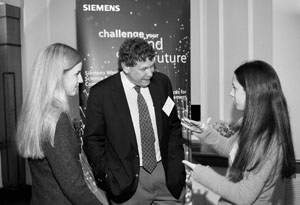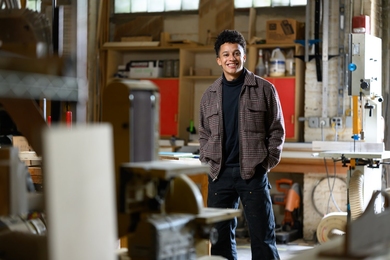A young man from a West Hartford, Conn., high school and a two-person team from an all-girls' high school in Hewlett Bay Park, N.Y., are the New England regional winners of the Siemens Westinghouse Science & Technology Competition.
The New England States regional event was held at MIT this past weekend. Five individuals and three teams, using visual and oral presentations, competed for college scholarships. The winners will advance to the national finals Dec. 1-3 in Washington, D.C., where they will compete for a top prize of $100,000.
Jacob Licht, a senior at the William Hall High School in West Hartford, won a $3,000 college scholarship for developing a new mathematical theory. Shira Billet and Dora Sosnowik of the Stella K. Abraham High School for Girls in Hewlett Bay Park, N.Y., won the team competition for their development of a viscometer for ultra thin lubricants. They will divide a $3,000 scholarship. All regional runners-up, which include individual contestants from Boston's Commonwealth School and Winsor School as well as Lexington High School, will be awarded $1,000 scholarships for their undergraduate or graduate education.
Licht's project is an original new mathematics theory based on the Ramsey Theory, which looks for pockets of order and connections within large, seemingly chaotic situations. His work turns this paradigm upside down, looking for pockets of complete disorder in systems that appear organized from a distance.
Professor David Vogan, head of the Department of Mathematics and one of the five judges, said Licht's paper was selected because of its originality and contribution to the field.
"It was clear to the judges that Jacob's work is extraordinary," Vogan said. "Here is a high school student who presented something on the level of a professional mathematician. It could easily be presented at a professional symposium. A mathematician's job is to think about possible theories and ways to count things so that when problems arise, applications exist to solve them. Even Einstein used existing theories to develop his own findings."
Licht embarked on his study during the last week of a six-week summer stay at the Research Science Institute, sponsored by the Virginia-based Center for Excellence in Education at MIT, where he studied the work of the century's greatest mathematicians. He hopes to continue pursuing mathematics at MIT, from which he's awaiting a response to his early-decision application.
THIN FILMS
Billet and Sosnowik won the team competition with a research project titled "A Viscometer for Ultra Thin Films." The duo developed a precise new way of measuring the viscosity of thin lubricants of film. The research, which tackles an important issue in the field of electronics and medicine, might mean good news for arthritis sufferers because the results can be applied to the building of artificial joints. It also has applications in electronics and micro-mechanical systems, where efficient lubricants must be applied in minute spaces.
"The students displayed sound knowledge of their topic and clearly demonstrated that this was a true collaboration and, more importantly, their own work," said judge Julian Sachs, assistant professor of paleoclimatology in the Department of Earth, Atmospheric and Planetary Sciences. "They even presented their lab notebook for review, which was impressive for high school students."
The other judges were Professors Mary-Lou Pardue of biology and Jacqueline N. Hewitt of physics. Lead judge Leslie C. Perelman, director of Writing Across the Curriculum in the Program in Writing and Humanistic Studies, said of all the contestants, "I'm always impressed with the level of knowledge and maturity these students possess. We constantly have to remind ourselves that they are still high school students."
Billet plans to pursue a career as a doctor or journalist;Sosnowik plans to study music or science and hopes to be a musician or doctor.
The competition is sponsored by the Siemens Foundation. Established in 1998, the foundation recognizes America's most promising science and mathematics students and teachers, as well as schools that strive promote education in the core sciences.
A version of this article appeared in MIT Tech Talk on November 7, 2001.






